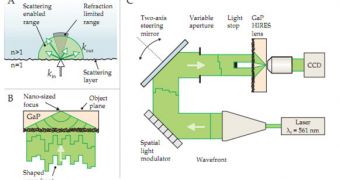A group of investigators was recently able to demonstrate that nanoscale objects can be successfully visualized, even if they break a threshold known among experts as the diffraction limits. Scientists in Europe have just demonstrated that this can be done successfully, by using a new type of lens.
Generally speaking, visible-light microscopes cannot see objects that are smaller than half of the wavelengths of the light they are using. This limits the size of objects that can be viewed with these microscopes to about 200 nanometers (nm).
This is about the size of a measles virus, experts say. In the new study, University of Twente researcher Allard Mosk and his team were able to image gold nanoparticles just 97 nanometers across.
According to the team, the wavelength of the laser beam used for this experiment was 561 nm. The scientists say that even better resolutions are possible, as soon as they refine their technology.
The lens the team used was the determining factor in guaranteeing success. It is made up of a piece of frosted glass. Such a device is obtained by etching the side of a transparent slab so that that particular side scatters all light that passes through.
When a plane wave of light slams into this slab, its photons are scattered in all directions. Some of them go on to pass through the lens, even if they are now heavily distorted, and no longer relevant for the message they were carrying before hitting the device.
Therefore, the light emerging on the other, clear side of the lens is a random speckle, that is analyzed by the experts using a CCD chip, This instrument can determine the shape of the distorted wavefront, Technology Review reports.
The setup used in the new experiments was a bit tweaked from this standard, in order for it to work. Experts introduced a spatial light modulator in the space between the wave of light and the lens.
This device is used to distort the wave in any way scientists see fit. Using the CCD data, the team programmed the light modulator to produce the same scattering pattern that the lens would produce.
But innovations don't stop here. The modulator is tweaked even further, in such a manner that the light exiting the lens after its gets scattered twice is actually focused, rather than returned to its original shape.
The higher visible-light resolution the team obtained is owed to the fact that the focal point of the modified light wave is a lot smaller than possible with ordinary lenses that use refraction alone.
“Our work is the first lens that provides a resolution in the nanometer regime at visible wavelengths,” Mosk and his team conclude.

 14 DAY TRIAL //
14 DAY TRIAL //